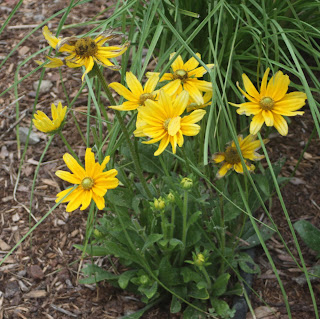I recently noticed some damage to one of my shrub dogwoods (
Cornus hesseyii Garden Glow). Several leaves on one stem were completely destroyed.
See?
As a biologist and a gardener I wanted to know what was causing the damage.
Secret 1 - Biologist are ALWAYS curious about the natural world.
I scratched my head a bit and recalled that some leaf damaging insects will stay on the plant but will hide under the leaves. So I looked under a half intact leaf and found these - Caterpillars!
Secret 2 - Biologist look under things.
Well, that didn't tell me what they ARE. So I hit the reference books.
Secret 3 - Biologists have LOTS of reference books.
No luck in the books. Caterpillars can be really hard to identify. First off they can look different at different ages. Second off there are few good identification guides. Third off the guides organize caterpillars by family, not by shape or color. It's a logical way to group them but when the book has around 450 pages it's not easy to flip through looking at all the images.
Secret 4 - Biologist look through all 450 pages anyway.
So I turned to the next best resource - one that can sometime be easier to look through. The Internet. I Googled several things - white and black caterpillar, white and yellow and black caterpillar, and such - before I hit on the right search - Dogwood caterpillars.
Secret 5 - Biologists know how to use Google.
Secret 6 - Biologist are persistent in their pursuit of knowledge.
Bingo!
These are
Macromphytis tarsatus. Say that five times fast. Heck, say that once! They are the larval stage of the Dogwood Sawfly.
See? They aren't even caterpillars! No wonder I couldn't find them in my books! Caterpillars are larva of butterflies and moths. These guys will grow up to be a type of wasp.
So what's the last secret? Remember yesterday's mystery caterpillar?
I couldn't find it either in my books or by internet searches so I sent the image out to a group of butterfly people (the MassLeps listserve) and asked.
Secret 7 - Biologists ask a friend, an acquaintance or a complete stranger who is an expert in the field.
This guy is a Tobacco Budworm (
Heliothis virescens) and it will grow up to be a drab looking moth. These caterpillars vary in color. It's possibly this color because the flowers of the snapdragon are red and it's eaten some of that pigment.
So there you go. The Seven Secrets that separate Biologists from normal people.
Do normal people write blogs about caterpillars?






















































